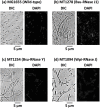Enzymatic activity necessary to restore the lethality due to Escherichia coli RNase E deficiency is distributed among bacteria lacking RNase E homologues
- PMID: 28542621
- PMCID: PMC5436854
- DOI: 10.1371/journal.pone.0177915
Enzymatic activity necessary to restore the lethality due to Escherichia coli RNase E deficiency is distributed among bacteria lacking RNase E homologues
Abstract
Escherichia coli RNase E (Eco-RNase E), encoded by rne (Eco-rne), is considered the global RNA decay initiator. Although Eco-RNase E is an essential gene product in E. coli, some bacterial species, such as Bacillus subtilis, do not possess Eco-RNase E sequence homologues. B. subtilis instead possesses RNase J1/J2 (Bsu-RNase J1/J2) and RNase Y (Bsu-RNase Y) to execute RNA decay. Here we found that E. coli lacking the Eco-rne gene (Δrne E. coli) was viable conditional on M9 minimal media by introducing Bsu-RNase J1/J2 or Bsu-RNase Y. We also cloned an extremely short Eco-RNase E homologue (Wpi-RNase E) and a canonical sized Bsu-RNase J1/J2 homologue (Wpi-RNase J) from Wolbachia pipientis, an α-proteobacterial endosymbiont of arthropods. We found that Wpi-RNase J restored the colony-forming ability (CFA) of Δrne E. coli, whereas Wpi-RNase E did not. Unexpectedly, Wpi-RNase E restored defective CFA due to lack of Eco-RNase G, a paralogue of Eco-RNase E. Our results indicate that bacterial species that lack Eco-RNase E homologues or bacterial species that possess Eco-RNase E homologues which lack Eco-RNase E-like activities have a modest Eco-RNase E-like function using RNase J and/or RNase Y. These results suggest that Eco-RNase E-like activities might distribute among a wide array of bacteria and that functions of RNases may have changed dynamically during evolutionary divergence of bacterial lineages.
Conflict of interest statement
Figures






Similar articles
-
Ribonucleases J1 and J2: two novel endoribonucleases in B.subtilis with functional homology to E.coli RNase E.Nucleic Acids Res. 2005 Apr 14;33(7):2141-52. doi: 10.1093/nar/gki505. Print 2005. Nucleic Acids Res. 2005. PMID: 15831787 Free PMC article.
-
RNase G complementation of rne null mutation identifies functional interrelationships with RNase E in Escherichia coli.Mol Microbiol. 2002 Mar;43(6):1445-56. doi: 10.1046/j.1365-2958.2002.02848.x. Mol Microbiol. 2002. PMID: 11952897
-
Nutrient dependence of RNase E essentiality in Escherichia coli.J Bacteriol. 2013 Mar;195(6):1133-41. doi: 10.1128/JB.01558-12. Epub 2012 Dec 28. J Bacteriol. 2013. PMID: 23275245 Free PMC article.
-
Bacillus subtilis mRNA decay: new parts in the toolkit.Wiley Interdiscip Rev RNA. 2011 May-Jun;2(3):387-94. doi: 10.1002/wrna.66. Epub 2010 Dec 16. Wiley Interdiscip Rev RNA. 2011. PMID: 21957024 Review.
-
RNA degradation in Bacillus subtilis: an interplay of essential endo- and exoribonucleases.Mol Microbiol. 2012 Jun;84(6):1005-17. doi: 10.1111/j.1365-2958.2012.08072.x. Epub 2012 May 8. Mol Microbiol. 2012. PMID: 22568516 Review.
Cited by
-
ExcludonFinder: mapping transcriptional overlaps between neighboring genes.Nucleic Acids Res. 2025 Jul 19;53(14):gkaf686. doi: 10.1093/nar/gkaf686. Nucleic Acids Res. 2025. PMID: 40705919 Free PMC article.
-
The Role of the Gut Microbiota in the Metabolism of Polyphenols as Characterized by Gnotobiotic Mice.J Alzheimers Dis. 2018;63(2):409-421. doi: 10.3233/JAD-171151. J Alzheimers Dis. 2018. PMID: 29660942 Free PMC article. Review.
-
Escherichia coli RNase E can efficiently replace RNase Y in Bacillus subtilis.Nucleic Acids Res. 2021 May 7;49(8):4643-4654. doi: 10.1093/nar/gkab216. Nucleic Acids Res. 2021. PMID: 33788929 Free PMC article.
-
Quasi-essentiality of RNase Y in Bacillus subtilis is caused by its critical role in the control of mRNA homeostasis.Nucleic Acids Res. 2021 Jul 9;49(12):7088-7102. doi: 10.1093/nar/gkab528. Nucleic Acids Res. 2021. PMID: 34157109 Free PMC article.
References
-
- Brenner S, Jacob F, Meselson M. An unstable intermediate carrying information from genes to ribosomes for protein synthesis. Nature. 1961;190:576–81. - PubMed
-
- Gros F, Hiatt H, Gilbert W, Kurland CG, Risebrough RW, Watson JD. Unstable ribonucleic acid revealed by pulse labelling of Escherichia coli. Nature. 1961;190:581–5. - PubMed
-
- Ghora BK, Apirion D. Structural analysis and in vitro processing to p5 rRNA of a 9S RNA molecule isolated from an rne mutant of E. coli. Cell. 1978;15(3):1055–66. - PubMed
-
- Lee K, Cohen SN. A Streptomyces coelicolor functional orthologue of Escherichia coli RNase E shows shuffling of catalytic and PNPase-binding domains. Mol Microbiol. 2003;48(2):349–60. - PubMed
MeSH terms
Substances
LinkOut - more resources
Full Text Sources
Other Literature Sources

